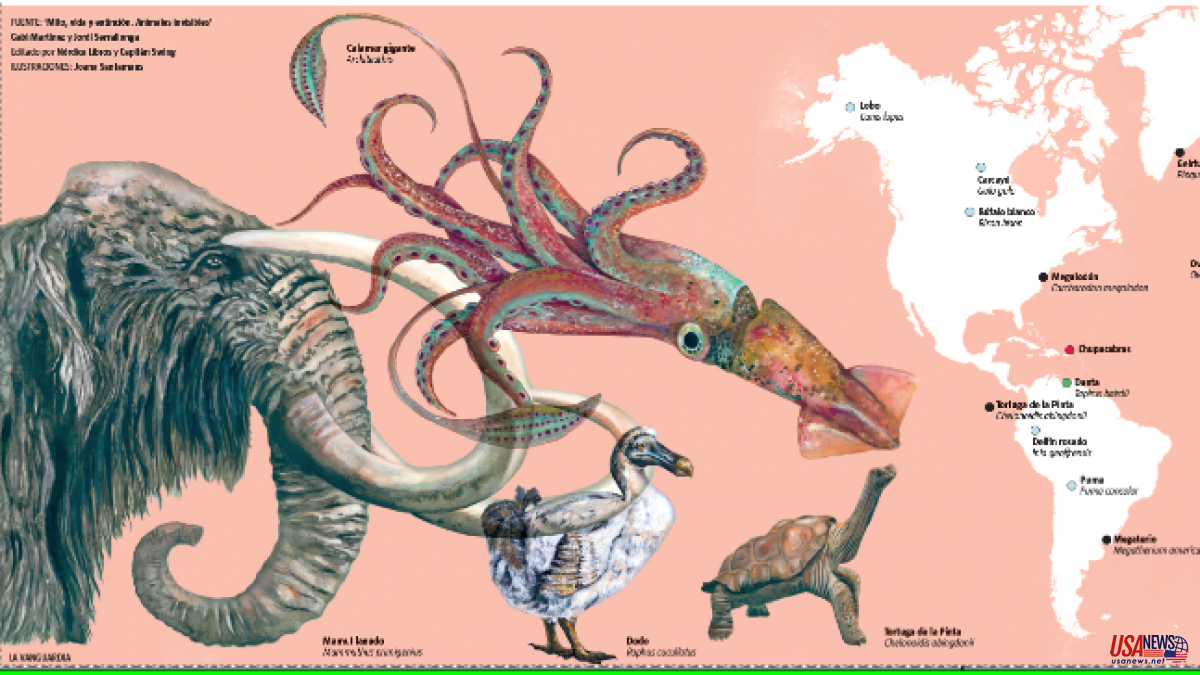While rulers and opponents fell apart as usual and millions of Venezuelans tried to survive another day, Óscar Pietri, owner of the La Guáquira Ecological Station, took a look in the rearview mirror, saw the five jeeps behind the one he himself was driving, looked at me and said:
-It had been twenty-five years since the government gave me a permit for…something. And you see, here we are. Thanks to an invisible animal.
He was referring to the tapir, as in Venezuela they call the tapir. I had traveled to the state of Yaracuy on the trail of that key animal in the national imagination, and which is now headed for extinction. The same tapir that appears ridden by Queen María Lionza, Goddess of Nature, in a sculpture at the entrance to Caracas; the same mammal – the largest in the country and one of the largest in the Neotropics – that many starving Venezuelans were eating for lack of other food. Searching for the tapir also revealed that some people had begun to eat jaguar, and endless singular stories that summarized the situation in the country.
Pietri realized that through this increasingly ghostly animal, he could not only explain many things in a different way, but even understand himself with former contenders, and he went to the unfriendly Department of Tourism in the town of San Felipe, where Mrs. Betty received the landowner with a shirt as red as that of all his chavista-madurista colleagues. Betty approved the idea of helping us overcome the three military checkpoints to attend the Columbus Day celebration in the Quibayo valley, where María Lionza and her tapir play a special role, so she provided three escort vehicles that joined that of Pietri, that of the cameras filming an improvised documentary and that of the five bodyguards.
That convoy sums up the strength of an invisible animal capable of uniting what politicians (and many others) cannot. It was a great moment for the Invisible Animals project, which had begun to take shape in Uganda in 2002, when I entered a ranger's cabin at the gates of the savannah crowded with pachyderms, lions, giraffes... and above all I saw photos on the walls. of a large plump bird with an enormous beak and a baleful look. The Arabs call it Abou Markhoub (slippery beak); scientists, Balaeniceps rex (king head whale); and here it is known by picozapato. They say there are between two and five thousand copies left distributed between Congo, Sudan and Uganda, but that number is an intuition. The truth is that the shoebill is shrouded in mystery and legend.
"Why are there so many shoebill posters?" I asked a ranger.
-Because this is the animal that we do not see.
But you're sure it still exists.
-There are many things that I have never seen but in which I believe. It would be very foolish to believe that the world is only what I see.
Years later, I investigated the murder of self-taught zoologist Jordi Magraner in the Pakistani Hindu Kush. After following the trail of the yeti for fifteen years, Magraner was beheaded. By then, he had saved thousands of people blocked by the war in the winter of the Panshir from death, and he achieved it thanks to his neutrality and knowledge of the territory treasured by kicking so many mountain ranges looking for the yeti. Magraner had witnessed in situ the appearance of the Taliban in the last place where Osama Bin Laden was undoubtedly seen alive, and his experience made us wonder why members of his family living in France voted for the extreme right. This story made it easy for me to talk about monsters much more intimidating than the yeti, as well as changing my life. And he confirmed the indisputable potential of invisible animals. My great archaeologist friend Jordi Serrallonga reached the same conclusion at the same time, so we started a joint project that is taking us all over the planet in search of the unseen. The Museu de Ciències Naturals de Barcelona will present an exhibition in 2024 that will address the invisible and the imagined.
We usually say that the dead man is to the noir genre what the invisible animal is to the travel genre: a plot line from which complete ecosystems can be told, and articulate a narrative faithful to The Great Conversation between humans and the rest of the species that Thomas Berry claimed as an indispensable condition if humanity intends to get ahead seriously. The invisibles are divided into mythical, extinct, and living but very difficult to see, for whatever reason.
Thus, through the Siberian tiger, it can be discovered that veterinarians from the two Koreas are negotiating to recover natural corridors altered by the appearance of the Demilitarized Zone, that strip saturated with mines that divides the two countries. The dodo reveals the drawbacks of being a flightless feathered animal: the Dutch clubbed it to death on Mauritius. The Ts'ikayo, a half-elephant, half-human being, reveals the scope of the fantasy of Hadzabe hunter-gatherers in Tanzania. The desire to rescue mammoth bones by bulldozer force warns of the dangers of the permafrost coming out, releasing deadly gases buried millions of years ago into the atmosphere. And, speaking of poisoning, in addition to countless birds, wolves, foxes and company, even mountain gorillas have suffered from biological poisons spread by hunters, farmers, ranchers... too "modern".
The invisibles reflect our ethics, they are a mirror that updates miseries and virtues, reminding us of what real interests we have and demonstrating the enormous margin for surprise that still remains in a world that we dream of being controlled. For example, last century we saw the coelacanth resurrect, that fish that had been extinct for 65 million years, reactivating the question about how many species will still remain hidden. It happened in South Africa, although Australia is the paradise of fossils. And Vietnam, that of unknown species: in 1992, a native warned about an unknown species of ox –ox!– in Vu Qang, the saola.
Each animal can be associated with an exemplary story that, well told, has the weight of a novel, and if the giant lizard of El Hierro slips the friendship between a climbing shepherd who practices Canarian wrestling and a biologist who did not know how to climb carved cliffs, the tortoise de la Pinta in the Galapagos exposes how Jorge, the last male of his species, became an ambassador for animal conservation, generating extraordinary marketing but, given his inability to procreate, some caricatured him as an impotent being taught to copulate by an ethologist.
Stories that explain to us, in short, much more than we often wish. Stories that present us even better than we sometimes think. In a hyperaudiovisual world, the invisible animal reminds that there are other ways of doing and telling. That it is often worth not seeing to better feel the beings around us.













